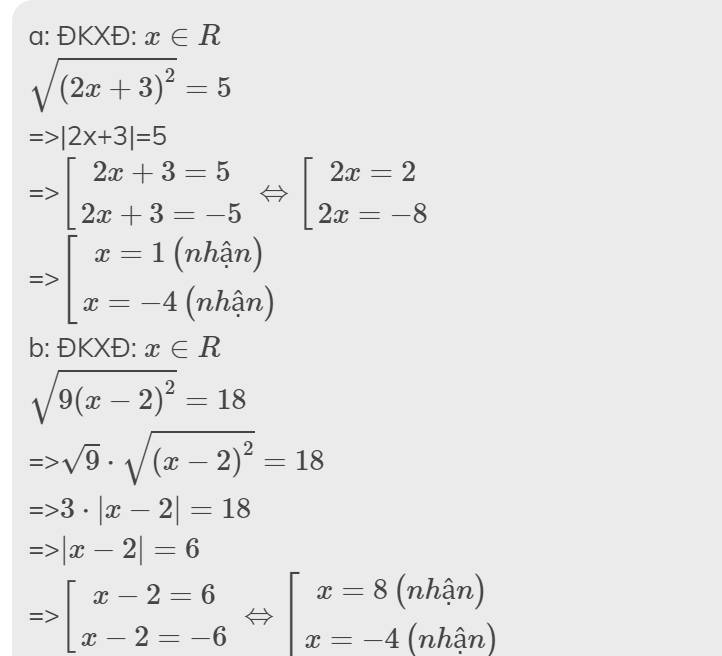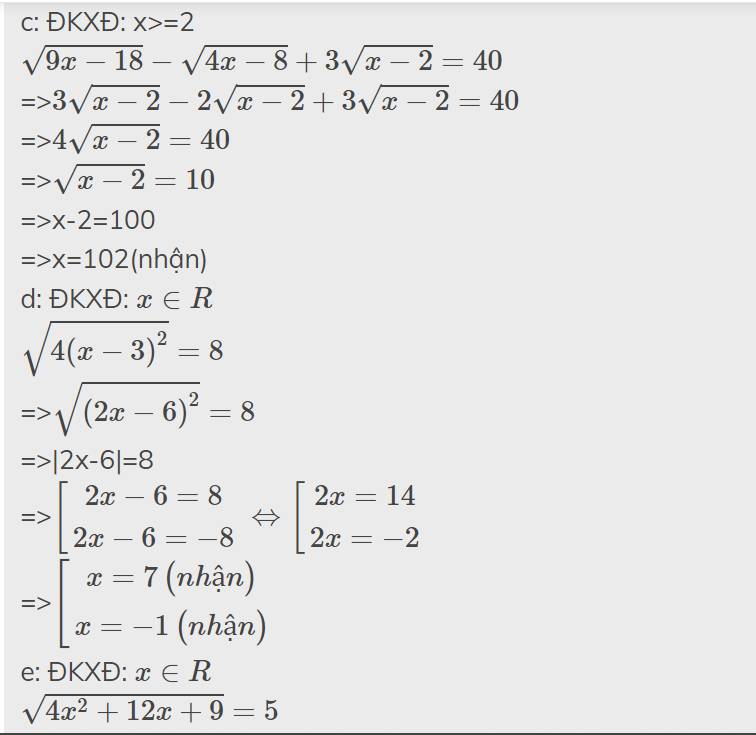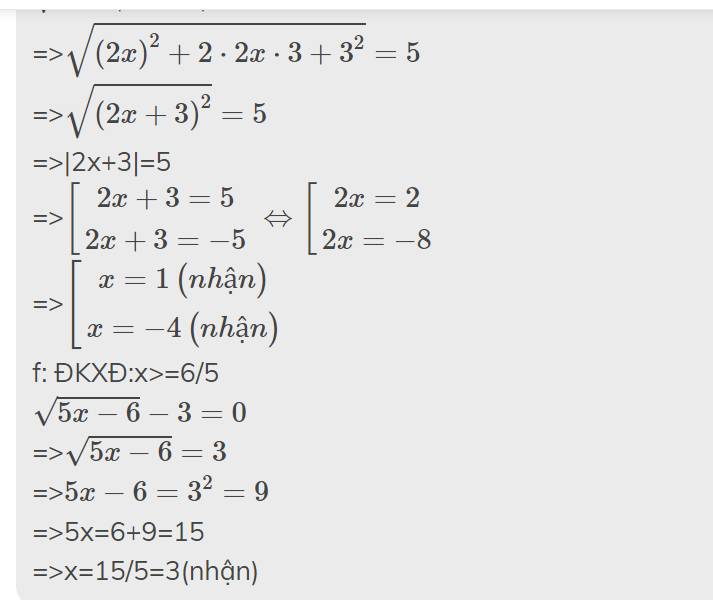giải phương trình:\(x^3-4x^2-5x+6=\sqrt[3]{7x^2+9x-4}\)
Hãy nhập câu hỏi của bạn vào đây, nếu là tài khoản VIP, bạn sẽ được ưu tiên trả lời.


a) \(x^3-4x^2-5x+6=\sqrt[3]{7x^2+9x-4}\)
\(\Leftrightarrow-7x^2-9x+4+x^3+3x^2+4x+2=\sqrt[3]{7x^2+9x-4}\)
\(\Leftrightarrow-\left(7x^2+9x-4\right)+\left(x+1\right)^3+x+1=\sqrt[3]{7x^2+9x-4}\) (*)
Đặt \(\sqrt[3]{7x^2+9x-4}=a;x+1=b\)
Khi đó (*) \(\Leftrightarrow-a^3+b^3+b=a\)
\(\Leftrightarrow\left(b-a\right).\left(b^2+ab+a^2+1\right)=0\)
\(\Leftrightarrow b=a\)
Hay \(x+1=\sqrt[3]{7x^2+9x-4}\)
\(\Leftrightarrow\left(x+1\right)^3=7x^2+9x-4\)
\(\Leftrightarrow x^3-4x^2-6x+5=0\)
\(\Leftrightarrow x^3-4x^2-5x-x+5=0\)
\(\Leftrightarrow\left(x-5\right)\left(x^2+x-1\right)=0\)
\(\Leftrightarrow\left[{}\begin{matrix}x=5\\x=\dfrac{-1\pm\sqrt{5}}{2}\end{matrix}\right.\)

Bài 1: ĐKXĐ: $2\leq x\leq 4$
PT $\Leftrightarrow (\sqrt{x-2}+\sqrt{4-x})^2=2$
$\Leftrightarrow 2+2\sqrt{(x-2)(4-x)}=2$
$\Leftrightarrow (x-2)(4-x)=0$
$\Leftrightarrow x-2=0$ hoặc $4-x=0$
$\Leftrightarrow x=2$ hoặc $x=4$ (tm)
Bài 2:
PT $\Leftrightarrow 4x^3(x-1)-3x^2(x-1)+6x(x-1)-4(x-1)=0$
$\Leftrightarrow (x-1)(4x^3-3x^2+6x-4)=0$
$\Leftrightarrow x=1$ hoặc $4x^3-3x^2+6x-4=0$
Với $4x^3-3x^2+6x-4=0(*)$
Đặt $x=t+\frac{1}{4}$ thì pt $(*)$ trở thành:
$4t^3+\frac{21}{4}t-\frac{21}{8}=0$
Đặt $t=m-\frac{7}{16m}$ thì pt trở thành:
$4m^3-\frac{343}{1024m^3}-\frac{21}{8}=0$
$\Leftrightarrow 4096m^6-2688m^3-343=0$
Coi đây là pt bậc 2 ẩn $m^3$ và giải ta thu được \(m=\frac{\sqrt[3]{49}}{4}\) hoặc \(m=\frac{-\sqrt[3]{7}}{4}\)
Khi đó ta thu được \(x=\frac{1}{4}(1-\sqrt[3]{7}+\sqrt[3]{49})\)

a: \(\Leftrightarrow\dfrac{1}{3}\sqrt{x-2}-\dfrac{2}{3}\cdot3\sqrt{x-2}+6\cdot\dfrac{\sqrt{x-2}}{9}=-4\)
\(\Leftrightarrow\sqrt{x-2}=4\)
=>x-2=16
hay x=18
b: \(\Leftrightarrow\left|3x+2\right|=4x\)
\(\Leftrightarrow\left[{}\begin{matrix}3x+2=4x\left(x>=-\dfrac{2}{3}\right)\\3x+2=-4x\left(x< -\dfrac{2}{3}\right)\end{matrix}\right.\Leftrightarrow\left[{}\begin{matrix}x=2\left(nhận\right)\\x=-\dfrac{2}{7}\left(nhận\right)\end{matrix}\right.\)
c: \(\Leftrightarrow3\sqrt{x-2}-2\sqrt{x-2}+3\sqrt{x-2}=40\)
\(\Leftrightarrow4\sqrt{x-2}=40\)
=>x-2=100
hay x=102
d: =>5x-6=9
hay x=3
\(\dfrac{1}{3}\sqrt{x-2}-\dfrac{2}{3}\sqrt{9x-18}+6\sqrt{\dfrac{x-2}{81}}=-4\) (đk: x≥2)
\(\dfrac{1}{3}\sqrt{x-2}-\dfrac{2}{3}\sqrt{9\left(x-2\right)}+6\sqrt{\dfrac{1}{81}\left(x-2\right)}=-4\)
\(\dfrac{1}{3}\sqrt{x-2}-2\sqrt{x-2}+\dfrac{2}{3}\sqrt{x-2}=-4\)
\(\dfrac{1}{3}\sqrt{x-2}-\dfrac{4}{3}\sqrt{x-2}=-4\)
\(-\sqrt{x-2}=-4\)
\(\sqrt{x-2}=4\)
\(\left|x-2\right|=16\)
\(\Leftrightarrow\left[{}\begin{matrix}x-2=16\\x-2=-16\end{matrix}\right.\Leftrightarrow\left[{}\begin{matrix}x=18\left(TM\right)\\x=-14\left(L\right)\end{matrix}\right.\)

Để giải các phương trình này, chúng ta sẽ làm từng bước như sau: 1. 13x(7-x) = 26: Mở ngoặc và rút gọn: 91x - 13x^2 = 26 Chuyển về dạng bậc hai: 13x^2 - 91x + 26 = 0 Giải phương trình bậc hai này để tìm giá trị của x. 2. (4x-18)/3 = 2: Nhân cả hai vế của phương trình với 3 để loại bỏ mẫu số: 4x - 18 = 6 Cộng thêm 18 vào cả hai vế: 4x = 24 Chia cả hai vế cho 4: x = 6 3. 2xx + 98x2022 = 98x2023: Rút gọn các thành phần: 2x^2 + 98x^2022 = 98x^2023 Chia cả hai vế cho 2x^2022: x + 49 = 49x Chuyển các thành phần chứa x về cùng một vế: 49x - x = 49 Rút gọn: 48x = 49 Chia cả hai vế cho 48: x = 49/48 4. (x+1) + (x+3) + (x+5) + ... + (x+101): Đây là một dãy số hình học có công sai d = 2 (do mỗi số tiếp theo cách nhau 2 đơn vị). Số phần tử trong dãy là n = 101/2 + 1 = 51. Áp dụng công thức tổng của dãy số hình học: S = (n/2)(a + l), trong đó a là số đầu tiên, l là số cuối cùng. S = (51/2)(x + (x + 2(51-1))) = (51/2)(x + (x + 100)) = (51/2)(2x + 100) = 51(x + 50) Vậy, kết quả của các phương trình là: 1. x = giá trị tìm được từ phương trình bậc hai. 2. x = 6 3. x = 49/48 4. S = 51(x + 50)

a: Ta có: \(\sqrt{4x+20}-3\sqrt{x+5}+\dfrac{4}{3}\sqrt{9x+45}=6\)
\(\Leftrightarrow2\sqrt{x+5}-3\sqrt{x+5}+4\sqrt{x+5}=6\)
\(\Leftrightarrow3\sqrt{x+5}=6\)
\(\Leftrightarrow x+5=4\)
hay x=-1
b: Ta có: \(\dfrac{1}{2}\sqrt{x-1}-\dfrac{3}{2}\sqrt{9x-9}+24\sqrt{\dfrac{x-1}{64}}=-17\)
\(\Leftrightarrow\dfrac{1}{2}\sqrt{x-1}-\dfrac{9}{2}\sqrt{x-1}+3\sqrt{x-1}=-17\)
\(\Leftrightarrow\sqrt{x-1}=17\)
\(\Leftrightarrow x-1=289\)
hay x=290

Bài 2:
a: =>2x^2-4x+1=x^2+x+5
=>x^2-5x-4=0
=>\(x=\dfrac{5\pm\sqrt{41}}{2}\)
b: =>11x^2-14x-12=3x^2+4x-7
=>8x^2-18x-5=0
=>x=5/2 hoặc x=-1/4



